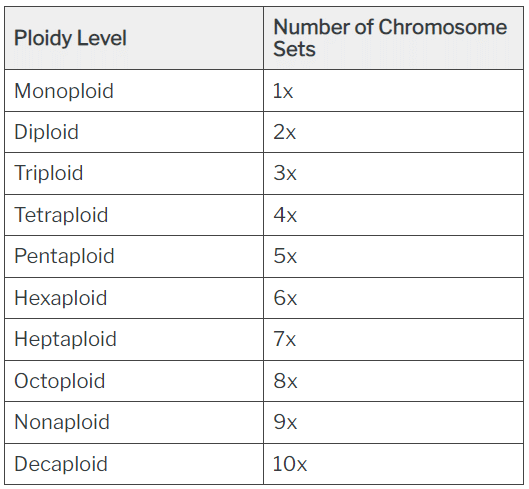Polyploidy, Euploids and Aneuploids | Agriculture Optional for UPSC PDF Download
Concepts for Polyploidy
Ploidy
The concept of polyploidy can be intricate. The terminology and symbols associated with polyploidy convey a great deal of information, and having a good grasp of these can help demystify and simplify this otherwise complex subject.
- Ploidy refers to the count of sets of chromosomes in a cell. Prefixes are employed to denote the number of chromosome sets in a specific organism. The symbol x is utilized to represent the count of chromosomes in a single set. For instance, monoploids possess one set (1x), and diploids have two sets (2x) of chromosomes, and so on.
Table: Corresponding number of chromosomes sets to ploidy level.
Polyploid
Polyploid is a general term that denotes the presence of multiple (more than two) sets of chromosomes. The genome refers to a collection of chromosomes inherited together, assuming normal processes of meiosis and mitosis. Each genome is made up of the fundamental chromosome number, represented as x, and each type of chromosome is found only once within each set.
Various symbols are employed as shorthand to convey additional information about the chromosomal makeup of a species or individual:
- n: signifies the haploid or gametic chromosome number of the species. (Please note that n does not provide information about the number of chromosome sets).
- 2n: indicates the diploid or somatic number of the species.
- x: represents the basic number of chromosomes in each set or genome.
For instance, a tetraploid, designated as 4x, has four genomes or sets of chromosomes. The chromosome count in its somatic cells is 2n = 4x, while the count in its gametes is n = 2x. In this example, let's assume the basic chromosome number is three, so x = 3. This means that each genome or chromosome set consists of three chromosomes.
Euploidy
Euploidy is a term used to describe a variation in the number of chromosomes, specifically referring to complete sets of chromosomes. Euploidy can involve either the loss or gain of entire chromosome sets.
In more specific terms, euploidy pertains to the chromosome count in an organism, which is a precise multiple of the basic chromosome sets. This means that there is more than one set of homologous chromosomes in the organism.
For instance, if the basic chromosome number is 2, it signifies the presence of 2 sets of chromosomes. Depending on this number, different types of euploidy can be identified:
- Haploid: one set of chromosomes (n)
- Diploid: 2 sets of chromosomes (2n)
- Triploid: 3 sets of chromosomes (3n)
- Tetraploid cells: a set of 4x chromosomes (4n) And so on.
Euploidy is more commonly observed in plants and less frequently in animals. In fact, the majority of euploids in both plants and animals are diploids (2n), which means that a euploid individual inherits a set of chromosomes from each parent, resulting in doubled homologous chromosomes.
Aneuploidy
Aneuploidy pertains to variations in the number of chromosomes within an organism. Specifically, it involves having either fewer or more chromosomes than the typical count due to the gain or loss of these genetic structures. Aneuploidy arises when one or more chromosomes fail to separate correctly during cell division.
Consequently, aneuploidy results in an abnormal chromosome count, deviating from the usual number. The type of aneuploidy is defined by the specific number of chromosomes that have been lost or gained, which can range from just one to multiple chromosomes. These types include:
- Monosomy (2n-1): In this condition, one chromosome is missing.
- Trisomy (2n+1): Here, there is an extra chromosome present.
- Nullisomy (2n-2): This aneuploidy involves the loss of two chromosomes.
Different types of aneuploidy are associated with specific chromosomal disorders. For instance, an individual with monosomy might have Turner syndrome, which occurs when one of the X chromosomes is missing in females. In contrast, conditions like Down syndrome result from trisomy, which involves having an extra chromosome, and Klinefelter syndrome occurs when males have an extra X chromosome.
Key differences between aneuploidy and euploidy
Euploidy and aneuploidy, although they may appear similar, have notable differences when comparing the two concepts.
Here's an explanation of the distinctions between euploidy and aneuploidy:
- Occurrence: Euploidy typically arises from complete cell nondisjunction or interspecies crossing, whereas aneuploidy occurs in other cases of cell nondisjunction and chromosome losses.
- Definition: Euploidy refers to the repetition of homologous chromosomes, signifying a duplicate or multiple of the entire chromosome set. In contrast, aneuploidy is characterized by changes in chromosome numbers within a chromosomal set.
- Type of Variation: Euploidy results in a significant increase in the number of chromosomes, leading to a substantial change in genetic material. Aneuploidy, on the other hand, involves changes in only one or a few chromosomes within the offspring cells, resulting in a relatively smaller alteration in the gene products.
- Frequency: Euploidy is more frequently observed in plants, while aneuploidy can occur in both plants and animals.
- Role: Euploidy, with the introduction of an additional homologous pair, can lead to the emergence of new species. Aneuploidy, by altering the chromosomal number, disrupts the genetic material balance within an organism.
In summary, the key differences between euploidy and aneuploidy relate to their causes, definitions, types of genetic variation, frequency of occurrence in different organisms, and their respective roles in evolution and genetic balance.
|
52 videos|224 docs
|
FAQs on Polyploidy, Euploids and Aneuploids - Agriculture Optional for UPSC
| 1. What is polyploidy? |  |
| 2. What are euploids? |  |
| 3. What is aneuploidy? |  |
| 4. How does polyploidy occur naturally? |  |
| 5. What are the advantages of polyploidy in plants? |  |
















